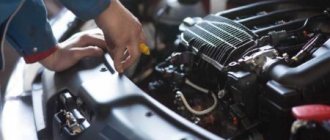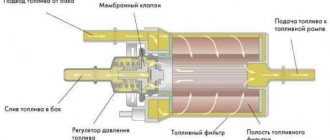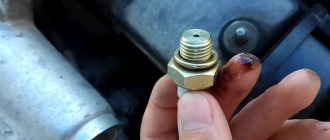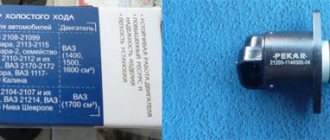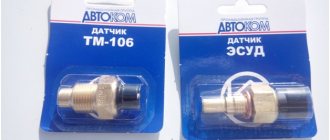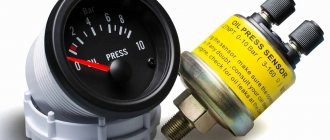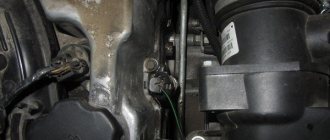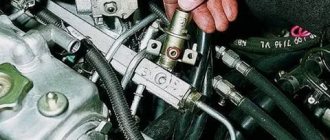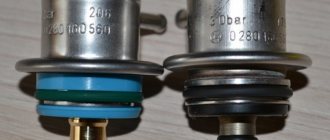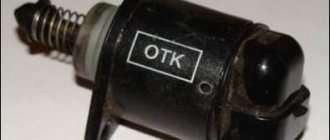The control system of any modern engine with an injection system consists of a huge number of sensors that depend on one another, and together they report to the electronic control unit about the condition of the engine. Based on this data, the ECU adjusts the main characteristics of fuel formation, the operation of the ignition system, right down to the operation of the transmission. And if one sensor or regulator gives incorrect readings, the engine will not work correctly. The fuel pressure regulator is also an important element for monitoring engine condition.
Fuel pressure regulator - signs of malfunction
The control system of any modern engine with an injection system consists of a huge number of sensors that depend on one another, and together they report to the electronic control unit about the condition of the engine. Based on this data, the ECU adjusts the main characteristics of fuel formation, the operation of the ignition system, right down to the operation of the transmission. And if one sensor or regulator gives incorrect readings, the engine will not work correctly. The fuel pressure regulator is also an important element for monitoring engine condition.
Withdrawal procedure
- The first step is to remove the fuel module.
- Then you need to lift the fuel module cover and disconnect the wire from the fuel pressure regulator.
Using a screwdriver, pry up and remove the spring clamp of the pressure regulator.
We take the regulator out of the cover.
What is a fuel pressure regulator
The entire injection system operates under a certain pressure. As in diesel engines, in order for the injector to operate and deliver the correct portion of fuel, it is necessary to strictly observe the nominal pressure, at which the injector not only supplies fuel in the required volume, it must also form a torch of a certain shape. Only then will the air-fuel mixture burn without residue, and the engine efficiency will approach optimal.
The fuel pressure in the line can be affected by anything, from a simple clogging of the fuel line or coarse filter, to incorrect operation of the fuel pump in gasoline engines and the injection pump, high pressure pump in diesel engines. Therefore, pressure must be controlled and maintained at least at the minimum acceptable level. This is what the fuel pressure regulator does. The signs of its malfunction are quite vague, which sometimes makes it difficult to detect the true cause of the engine’s incorrect operation, but we’ll certainly sort them out today.
Installation locations
On cars, the injection system is equipped with a separate line for draining excess gasoline, which goes from the fuel rail to the gas tank (fuel recirculation). In such injectors, the regulator is installed directly on the fuel rail (or connected to it), so the unit quickly “reacts” to changes in engine operating conditions and adjusts the pressure in the rail. In this design of the power system, a mechanical type RTD is used.
There is another version of the injector - without gasoline recirculation. In this system there is no “return” at all, and regulation is carried out at the output of their fuel pump. A feature of such a system is the location of the regulator - in the tank or near it. An RTD is already used here, the operation of which is controlled by the ECU - the control unit, through a sensor installed in the ramp, monitors the necessary parameters and corrects them by sending signals to the regulator.
Power systems with electronic regulators are used less frequently than mechanical ones due to their complex design and, accordingly, lower reliability.
The principle of operation of the VAZ fuel pressure regulator
To clearly control stable movement in the fuel rail, when the pressure is low, to send an alarm to the electronic control unit, and when the pressure is high, to let fuel flow through the return channel - these are the main tasks of the pressure regulator. Electronics has no logic; it is guided only by dry data. Depending on the car model and the number of special sensors, the source of the malfunction can be more or less accurately localized. In simple injection systems, such as in VAZ cars, diagnostics consists not so much in the ability to correctly read error codes on the diagnostic port, but in knowing the interconnection of system elements.
The fuel pressure regulator in power systems without a return channel is installed in the fuel tank; such systems are practically not used. The regulator that works with the recirculation system has three pipes.
- Inlet pipe.
- Atmospheric pressure control pipe.
- Fuel return channel pipe.
The regulator is technologically divided into two chambers, one of which is air, the second is fuel. They are separated by a membrane, which is under the action of a check valve spring. In that case. if the pressure in the system exceeds a certain parameter, and it is slightly different for all gasoline engines, then the spring is weakened, the pre-bypass valve opens and excess fuel goes back into the tank, where, passing through the filter, it again enters the fuel rail.
Operating principle of RTD
The valve design and operating principle depend on the type of fuel system of a particular vehicle. There are 3 ways to supply gasoline from the tank to the injectors:
- The pump together with the regulator is installed inside the tank; fuel is supplied to the engine through one line.
- Gasoline is supplied through one tube and returned through another. The fuel system check valve is located on the distribution rail.
- The circuit without a mechanical regulator provides for electronic control of the fuel pump directly. The system contains a special sensor that registers pressure; the pump performance is regulated by the controller.
In the first case, the return flow is very short, since the valve and electric pump are interlocked into a single unit. The RTD, located immediately after the supercharger, dumps excess gasoline into the tank, and the required pressure is maintained throughout the supply line.
Reference. The first scheme with a regulator inside the gas tank has been implemented on all Russian-made VAZ cars.
The second option is used in most foreign cars. A valve built into the fuel rail allows excess fuel to flow into the return line leading to the tank. That is, 2 gasoline pipes are laid to the power unit.
There is no point in considering the third circuit - instead of a regulator, there is a sensor whose functionality is checked using a computer connected to the diagnostic connector.
A simple fuel pressure valve installed in the fuel pump unit consists of the following elements:
- cylindrical body with pipes for connecting the supply and return lines;
- a membrane connected to a locking rod;
- valve seat;
- spring.
The amount of pressure in the supply line depends on the elasticity of the spring . While most of the fuel goes into the cylinders (high load on the engine), it keeps the membrane and valve stem closed. When the crankshaft speed and gasoline consumption decrease, the pressure in the network increases, the spring compresses and the membrane opens the valve. The fuel begins to be discharged into the return line, and from there into the gas tank.
The fuel pressure regulator installed in the rail operates on a similar principle, but reacts faster to changes in load and gasoline consumption. This is facilitated by connecting an additional pipe of the element to the intake manifold. The higher the crankshaft speed and the vacuum on the spring side, the stronger the membrane presses the rod and closes the passage of fuel into the return line. When the load decreases and the speed drops, the vacuum decreases and the rod releases - the return flow opens and excess gasoline begins to be discharged into the tank.
Main malfunctions of the regulator
As can be seen from the design of the device, there is practically nothing to break there. Over time, the spring may lose elasticity, and then the pressure will change and the engine will not receive the required amount of gasoline. In this case, the electronic control unit will try to make the mixture as rich as possible, adjusting the ignition timing to the lean mixture, and this already causes incorrect operation of the engine and excessive consumption of gasoline. But the main indicators that the pressure regulator requires at least checking are:
- unstable engine operation at idle;
- the engine often stalls when moving from a stop at minimum or idle speed;
- unstable speed, floating engine speed;
- deterioration in dynamics;
- excessive fuel consumption;
- difficult start-up after a long period of parking;
- power drop.
And it is intuitively clear that the engine is choking, judging by its operation. These symptoms are characteristic not only of the pressure regulator, but if all of them are present in full, then it makes sense to check, and most likely replace the regulator.
Main elements of the fuel system of an injection engine
The injector is a complex mechanism for supplying fuel to the cylinders. The entire fuel supply process is controlled by the engine's electronic control unit (ECU). The fuel supply system also uses a parallel air supply.
Fuel pump glass
The fuel pump cup is a collection of the main elements of the fuel system assembled on one site.
The fuel pump glass includes:
- Gasoline pump
- Coarse filter
- Fuel level sensor
- Fuel pressure regulator (only in 1.6 liter engine versions)
Gasoline pump
It is one of the main elements of the fuel system. Serves to supply fuel to the cylinder block under pressure. A fuel pump is a kind of electric motor. Its operation is based on the principle of centrifugal force. Under the influence of the magnetic field formed in the stator of an electric motor, its armature is given rotation. A pump volute is installed on the anchor shaft, which directly pumps pressure into the fuel system.
The gasoline pump is very capricious and picky about the purity of the fuel consumed. Most often, the fuel pump fails due to low-quality fuel or its lack in the tank. In order for the gas pump to last as long as possible, it is necessary to refuel at proven gas stations and keep at least 25% of the tank volume in the car’s tank. If you drive with the fuel light on, the fuel pump will most likely fail much faster, since if there are bumps, the gasoline in the tank will squish from side to side and the fuel pump will suck in air.
Injectors and fuel rail
The fuel rail serves as a kind of case for the injectors; it is in it that they are installed.
The injectors of an injection engine are also one of the most important elements of the fuel system. Designed to supply fuel to the engine cylinder block under pressure. The injector sprays fuel into small droplets for better and easier ignition in the cylinder.
Checking, replacing, price of VAZ fuel regulator
You can judge the condition of the regulator only after checking it, since we have already said that these symptoms may also indicate other malfunctions. The nominal pressure in the fuel rail of VAZ cars with an injection power system is from 0.3 to 0.7 bar. This is exactly the parameter that the pressure gauge should show when connecting it to the ramp. At lower pressure, the fuel will go back into the tank, and the next time you start it, you will have to turn the engine with the starter for quite a long time to start it.
Replacing the fuel pressure regulator will cost from 600 to 800 rubles, depending on the manufacturer. The old regulator is not treated and is disposed of, and a new one, after releasing the pressure, is installed in its place. Check your blood pressure more often and have a good trip everyone!
Source
How to check the fuel rail? Checking the RTD yourself
Checking the fuel pressure regulator is carried out to identify malfunctions or for prevention.
Such checks are carried out based on the recommendations of the car manufacturer. But still, how to check the pressure in the fuel rail? Basically, the check consists of inspecting and checking the pressure of the fuel system at various engine speeds. Then comparisons are made with indicators that correspond to the norm. It is necessary to carefully inspect the tightness of the connections, the condition of the vacuum hose, as well as the regulator itself. If no damage or defects are found, then the regulator is dismantled by completely disassembling it. If a blockage is detected in this unit, it is washed.
Important: the pressure in the fuel rail should be diagnosed using a pressure gauge. It is connected to a special diagnostic fitting.
How to check the fuel pressure regulator. Fuel pressure regulator diagnostics
You can also check the regulator yourself. To do this, you do not need to use any special tools or have any special auto mechanic skills. You will need to pinch or disconnect the valve and observe the force of the jet. Or for a better check, use a pressure gauge.
To measure the RTD pressure in the engine when turning on idle speed, it is worth connecting a pressure gauge, installing it between the fuel hose and the fitting. Don't forget to disconnect the vacuum hose. Below we will look at what pressure should be in the fuel rail of a VAZ 2110.
When measuring the pressure in the fuel rail with your own hands, the pressure should begin to increase from
0.3 to as much as 0.7 Bar.
If the pressure remains in place, repeat the procedure. It happens that after a number of necessary procedures, the pressure remains the same. This means that the regulator is faulty and cannot be repaired. It needs to be replaced.
How do malfunctions of the fuel pressure regulator affect engine performance?
A faulty regulator valve affects not only operation, but also the very start of the engine.
If the device is working properly, the pressure in the fuel rail does not drop after the engine stops. If the valve has a malfunction, then the pressure in the fuel rail drops when the engine stops. The engine will not start until the sediment has completely filled the system. And only after reaching the desired level, the first engine start signals may appear. Here everything will depend on the power of the battery. Otherwise, the engine will not be able to start. Therefore, if the pressure in the fuel rail does not hold, this indicates a malfunction! In addition to the above, gas failures may occur during acceleration of the car, unstable idling, and a general weakening of engine power will begin to appear.
Injector purpose
Installing an injector in the VAZ 2107 made it possible to significantly improve engine performance. Changing the type of fuel system increases the amount of energy that is produced during the combustion of gasoline. Compared to a carburetor engine, a fuel injection system is more efficient in the initial stages, but over time its performance decreases. What does this depend on?
VAZ 2107 injector plays the role of the final element in the fuel system of the car. The air mixture, together with a cloud of atomized gasoline, creates a huge amount of energy. Over time, this atomization may become less effective, the fuel jets will become weaker, and all due to low-quality gasoline.
Cleaning and preventing plaque in the system
The injector device is very sensitive to large inclusions in gasoline. If you are using a cheap brand of fuel, be prepared to change your injectors soon. So the first thing you should do for your VAZ fuel pump is change the brand of fuel. The power supply system of the VAZ 2107 should become cleaner; the possibility of plaque formation in the system is still not excluded. Since the flammable liquid in the channels occasionally stagnates and sometimes even freezes, an early breakdown can be prevented only in one way - regular cleaning.
Approximately every 35-40 thousand km it is necessary to carry out preventive cleaning work on the fuel system. You need to wash the channels with your own hands. The performance of the engine will depend on the quality of cleaning. If this procedure is carried out irregularly, then soon you can say goodbye to one injector and look for a new one, and then you will have to change the remaining elements of the VAZ fuel pump.
In 4-cylinder types of injection engines, different intensities of injector clogging are observed. The temperature in the area of cylinders 2 and 3 is always elevated, so sediment accumulation occurs there faster.
A special admixture of polyetheramine is considered a prophylactic agent in such cases. It prevents the accumulation of burning for a long time.
Damage diagnostics
How to understand that an injector needs to be replaced, checked or repaired? Even without sensors, you can understand that repair of fuel system elements is required if there are 1 of 2 main signs in models 2107, 21074:
- Unstable engine operation. Sometimes it may stall or have difficulty starting.
- A much less obvious sign is loss of power. This effect is noticeable if you mostly drive at medium speeds, but at high speeds it is very noticeable.
- The last sign is recorded only by sensors - the pressure inside the system increases.
The cause of such failures is clogged injectors; even diagnostics are not needed. Cleaning helps restore the engine to its original performance. If the problem has not been resolved after cleaning, it is worth checking the tubes and injectors for damage or breakdowns. In such cases, it is better not to start repairs, but simply replace the damaged parts with new ones.
Sometimes it is impossible to determine on your own where the damage is, and only then will diagnostics at service centers come in handy. A blockage can cause quite serious damage to the VAZ 2107 injector, as well as rupture of channels. The pressure that arises inside the system can easily destroy the most fragile parts. Here you won’t be able to fix the situation with your own hands, even if you have a complete diagram of the car at hand. There is only one conclusion - you need to devote a lot of time and attention to cleaning injectors and do it regularly.
Why do you need a fuel pressure regulator?
As mentioned above, this regulator maintains the required fuel pressure necessary for normal operation of the injectors, taking into account one or another operating mode of the power unit. In other words, the RTD affects the amount and intensity of the fuel supply that enters the engine cylinders through the injectors.
Simply put, the amount of fuel supplied to the engine at the time of injection depends on the pressure that is created inside the fuel rail (rail), as well as on the pulse duration for opening the injector and the vacuum in the intake manifold.
For more accurate dosing and maintaining constant pressure, a diaphragm valve-regulator is used, which experiences fuel pressure on one side, and a spring force on the other. RTD is used in power systems where there is a so-called “return”. The regulator is installed at the fuel rail. Also, this element can be located in the fuel tank, while such systems do not have a return line.
- Let's first look at the common design in which the regulator is located in the fuel rail. The element operates on the following principle: the fuel pump forces fuel from the fuel tank along the line. The resulting fuel pressure acts on the regulator. The device itself has two chambers (a spring chamber and a fuel chamber), which are separated by a membrane. On one side, the membrane is pressed by fuel, which enters the regulator through special inlet holes, and on the other side, there is spring pressure and intake manifold pressure. If the fuel pressure turns out to be stronger than the spring force and the pressure in the inlet, then the regulator opens slightly, resulting in some of the fuel being discharged into the return line. The fuel returns through the return line to the fuel tank.
- In systems without a return line, the regulator is usually located directly in the tank. The advantages include the absence of an additional pipeline. The injectors are supplied with the required amount of fuel directly from the tank, that is, excess fuel does not enter the engine compartment, and there is no need to deliver it back to the tank. This also allows us to talk about less heating of the fuel and provides a number of additional advantages in the form of less intense evaporation.
Device
The VAZ 2107 injector consists of the following elements:
- Computer;
- Sensors;
- Fuel pipes and hoses;
- Fuel and air filter;
- Actuators;
- Gas tank;
- Wiring.
The injector power system contains the main element - a computer or ECU. Its permanent memory contains a program (algorithm) in accordance with which the control of actuators is implemented, these include:
- Fuel pump;
- Injectors;
- Idle air control;
- Canister valve.
Each of the above elements performs its own function.
Gasoline pump
Turned on by the ECU output signal through a relay. Has a strainer and fuel level sensor. The gasoline from it passes through the fuel filter. The pump is located in the tank and to remove it, you need to remove the back seat, remove the hatch and unscrew the fastener.
Nozzle
It is a sprayer equipped with a solenoid valve. Triggered by an ECU impulse. Accordingly, the duration of valve opening (the amount of gasoline supplied) depends on the time the pulse is applied. It is installed on a ramp common to all injectors, a constant pressure in which is maintained by a valve. If it is exceeded, the valve opens and gasoline returns back to the tank. The injector enters the intake manifold. The air flow, passing through the intake manifold, carries away a portion of gasoline ejected by the nozzle.
The structure of the VAZ 2107 fuel system
Idle speed control
The fuel system maintains engine idle speed using a regulator. It is a stepper motor connected to a conical shaped control body. Its approach reduces the air flow entering the intake manifold; its removal, on the contrary, increases it.
Canister valve
It is needed to turn on the ventilation of the adsorber, which accumulates gasoline vapors and releases them into the intake manifold at the right moment.
The injector power system contains sensors for measuring, converting and transmitting the signal to the computer.
The following sensors are installed on the VAZ 2107:
- Crankshaft position;
- Mass air flow;
- Throttle position;
- Coolant temperature;
- Speed;
- Oxygen content in exhaust gases.
Fuel pressure regulator malfunctions
Problems in the engine power system can vary. For this reason, during diagnosis it is necessary to look for certain signs of a malfunctioning fuel pressure regulator. Most often, the main symptoms are considered to be when the engine does not pick up speed and does not develop full power, and also stalls in different operating modes. In the list of main signs, experts note:
- unstable operation at idle, the unit stalls at idle;
- loss of power, noticeable increase in fuel consumption;
- slow reactions to pressing the gas pedal;
- jerks and dips during acceleration, at the moment of throttling;
- the car does not accelerate, does not gain momentum;
Note that the malfunction of the RTD on gasoline cars is similar in symptoms to common problems with the fuel pump or its strainer. For this reason, when determining faults in the power system, a mandatory check of the fuel pressure regulator is necessary.
In other words, if the car stalls at idle, the engine power is lost, dips appear, the car jerks during acceleration or when changing gears, significant fuel consumption is noted, then the problem may not only be in the fuel pump grid, the motor or its relay, but also in the fuel pressure regulator.
Regulator malfunctions usually come down to the fact that the spring loses the required force, as a result of which the fuel is prematurely drained into the “return”, and the engine simply does not have enough fuel when you press the gas and increase the speed, as well as in transient modes. It turns out that the pressure in the fuel rail when the fuel pressure regulator spring is faulty is low, as a result of which the engine runs unstably, engine power decreases, the ECU is not able to correctly adjust the mixture composition for different operating modes, etc.
Failures in the operation of the RTD are also possible when the pressure regulator in the fuel rail begins to jam at certain intervals. In such cases, pressure drops occur in the fuel supply system, and the car begins to twitch. Let us add that the most common reasons for regulator failure, which results in signs of malfunction of the fuel pressure regulator on a diesel or gasoline car, also include wear and tear of the materials inside the device, that is, the valve simply wears out its service life over time. The service life and condition of the regulator are affected by the quality of the fuel and the content of various impurities in it, long periods of vehicle downtime without starting the engine, etc.
No pressure in the fuel rail, reasons
The presence of a certain pressure in the fuel rail of an injection engine is one of the conditions for its operation.
Using the example of the fuel rail of the fuel injection system 2111 of the VAZ 21093 (21083, 21099) car, we will consider the signs and reasons for the disappearance or decrease in gasoline pressure in it.
Signs that there is no pressure in the fuel rail
Car engine does not start
The starter turns, but there are no or infrequent sparks in the cylinders.
The car engine starts and immediately stalls
After starting, the engine makes a few revolutions and stalls.
Unstable engine speed at idle
The engine jerks, shakes, and tries to stall when idling.
Dips, jerking and jerking after pressing the gas pedal
When pressing the gas pedal, instead of the expected increase in speed and pickup while the car is moving, the driver feels that the engine is trying to stop and stall - failure or several such attempts extended over time - jerking and jerking.
Reduced power and throttle response of a car engine
The car's former agility and engine traction have disappeared somewhere; the car can barely pull.
Causes of the “no pressure in the fuel rail” fault
Fuel pump faulty
The electric fuel pump cannot create the required pressure in the fuel system due to its malfunction or a malfunction of the electrical switching circuit. If the pump fails completely, then there can be no question of any pressure in the fuel rail.
Fuel filter clogged
When the fuel filter of the fuel injection system becomes clogged, its throughput decreases (in some cases it disappears altogether). As a result, gasoline cannot be pumped into the fuel rail by the gasoline pump with sufficient pressure, or maintaining the required pressure at different engine operating modes becomes impossible. See “Signs of a clogged fuel filter in the fuel injection system.”
